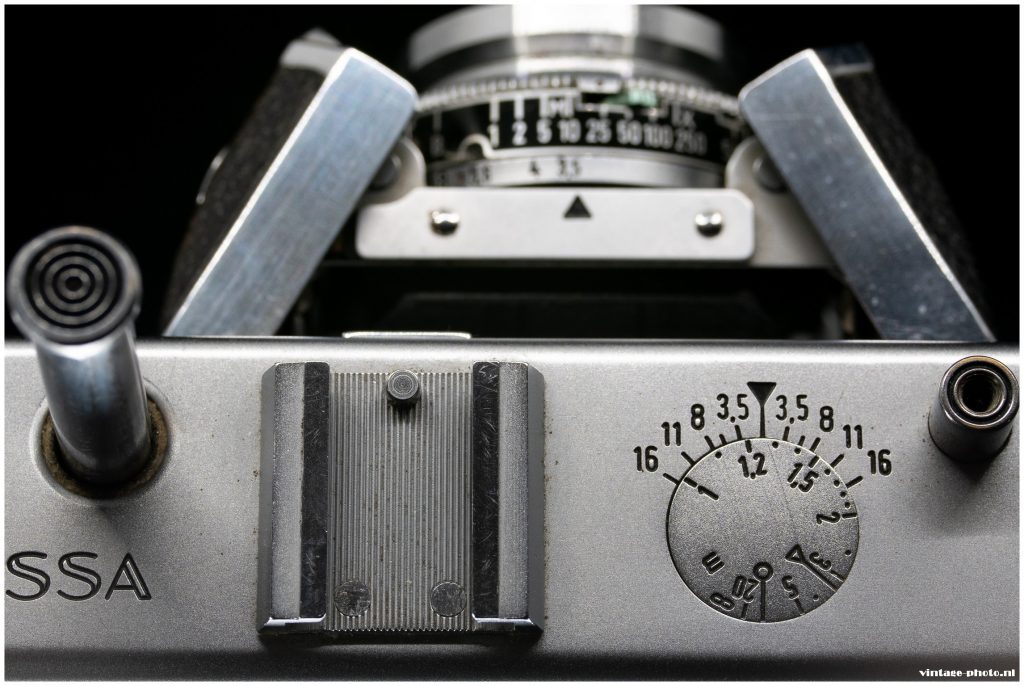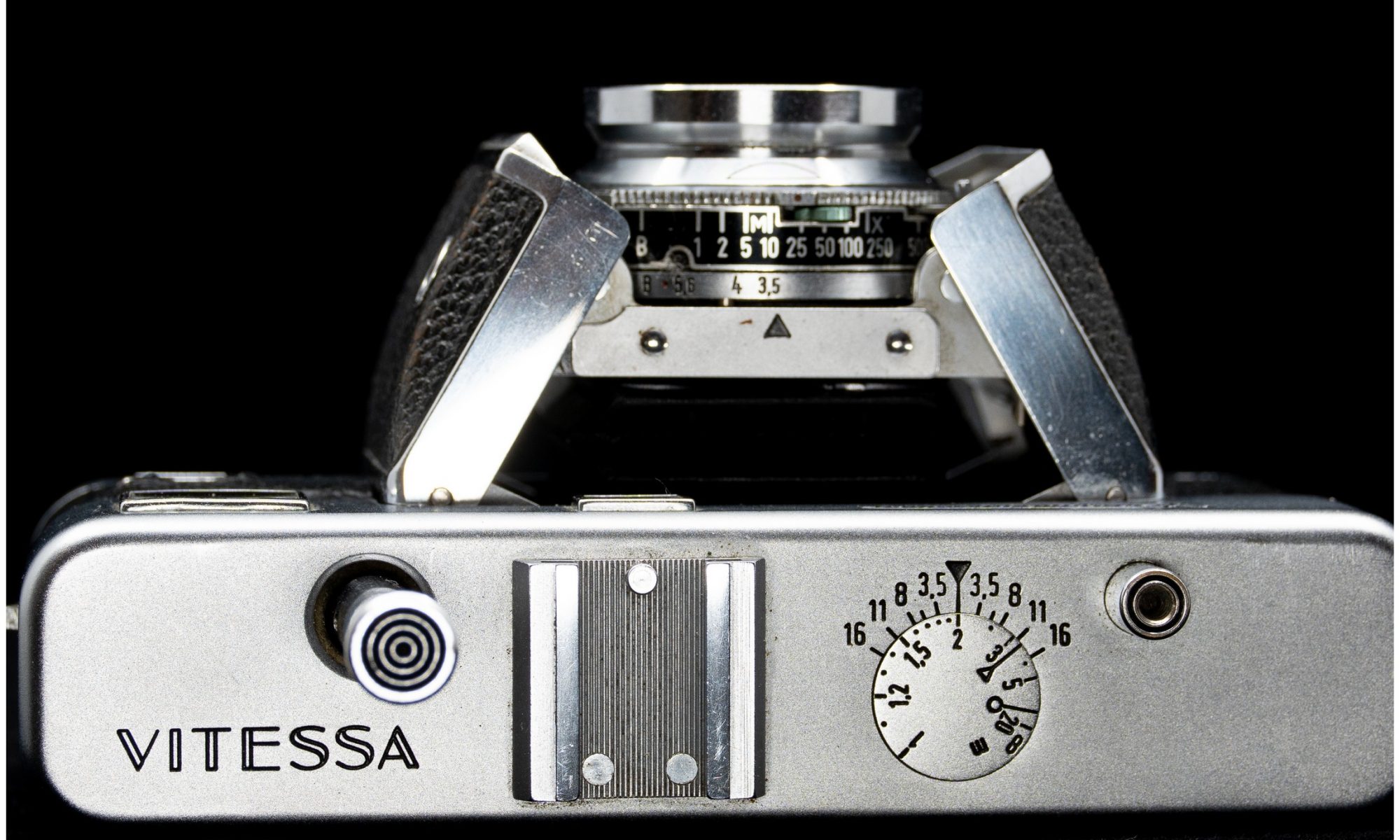At first glance, a strange camera. A long protruding plunger and a barn door. That’s the first thing to notice, so not Voigtlander. But it’s not until you understand the reasons that you notice the craftsmanship and sense of design with which this 35mm rangefinder camera was made.
The Germans called this Vitessa by its nickname in the fifties: ‘Leuchtturm’ or ‘Lighthouse’. A beautiful and at the same time strange, incomparable camera. No other brand had a comparable design. Who would venture into such a newfangled design of which it remains to be seen whether users would appreciate it. A second nickname for the Vitessa is ‘Scheunentor’ or ‘Barndoor’ because of the opening parts of the lens housing. These then remain open at an angle like a door that can be closed again at any moment. But folded shut and the plunger pushed in, it is an extremely light and compact camera. Made entirely of metal, neatly finished in every detail to the highest German quality standards.


My model is the Vitessa model A, version 5 from 1954, without a (selenium) light meter, which is found on other models. In the barn there is a Color Skopar F3.5 50 mm lens (still made by Cosina in Japan). The shutter is located directly behind the lens and is equipped with a precise Synchro Compur with a fastest shutter speed of 1/500s. The aperture is also controlled on the lens. Two large setting wheels for shutter speed and aperture. You have to dare to put your fingers between the doors, because you keep the idea that they can close again just like that, but nothing could be further from the truth. The Vitessa is securely locked for use.


Also located on one of the doors is the flash contact, a PC sync connection that is fully synchronized for all shutter speeds. This can handle manual or electronic flashes. With me, it came with an old-fashioned Bulb flash with that nice fold-out umbrella screen. More vintage is hardly imaginable.
On the front there is also the automatic counting mechanism for the film roll. Furthermore, we see the viewfinder and rangefinder window (equipped with an automatic parallax correction for close-up shots). This ensures that the angle of view remains identical to that seen through the viewfinder. But don’t expect a large viewfinder image here. also the rangefinder patch is small and requires accurate searching for precise focus. That focusing is done with a small dial on the back of the camera. This works smoothly and also indicates the distance closely. Matching aperture values are also indicated.


An interesting detail is that this is a bellows camera! The compactness is made possible by folding the lens in and out through leather bellows.
The Voigtländer Vitessa is one of the most unique 35mm cameras ever made. On the top there are also two large buttons, the shutter button and then that tall plunger. It reminds me of my Konica where the developers were also looking for an innovation way for winding the film. Here, instead of a lever, a press on the long plunger is needed to a) advance the film and b) cock the shutter. So: press the plunger all the way down, press the shutter button, plunger all the way down again, next picture. Luckily the plunger doesn’t give much resistance, it goes smoothly as long as you have long fingers.


At the bottom of the camera are the rewind lever, the film release knob and a latch to detach the whole back of the camera. Inserting a film is extremely easy and also the rewind knob can be extended to quickly rewind the roll. By the way, the film runs from right to left. There is also a tripod connection.
In practice, this is a rangefinder camera that you want to be seen with, but also one that takes (very) good and sharp pictures because of the quality Skopar lens. The lens unfolds quickly and is immediately ready for use. The plunger does a good job and turns out to be very reliable. It is certainly not a ‘typical’ Voigtlander camera, but one that is literally head and shoulders above the ‘usual’ cameras for the time. A collectible worthy of its name.



Don’t expect Leica quality, but think lush soft contrast, adequate sharpness and beautiful, sometimes leaping wild colors. A camera that you will want to use more times and also arouse much interest through its striking design.
It is the most captivating Vitessa model, the later modern series remain in the shadow of this original.
You need a manual for the Voigtlander Vitessa?


I recently bought a 1956 Vitessa on eBay. The only problem so far is that I cannot get the plunger to stay down in its locked position when the camera is closed. Is there a trick to doing it? It was fully down when the camera arrived.
Push the plunger down until there is about a half inch still out, then let go. Do not push it all the way in to lock it.
Hi John, as far as i know the plunger only locks itself fully down when the barn doors are (fully) closed.
Many years back German cameras were the leaders , with Voigtlander in the top bracket.Myself owned a Baldamatic and late uncle Zeiss Ikon Contarex All these precision built with Minox a must have with spies.
A great shame that they have gone but still work
Mine is the “L” (first version) with an Ultron lens. High resolution without biting sharpness, dead on colour rendition. An all-time favourite user for me.